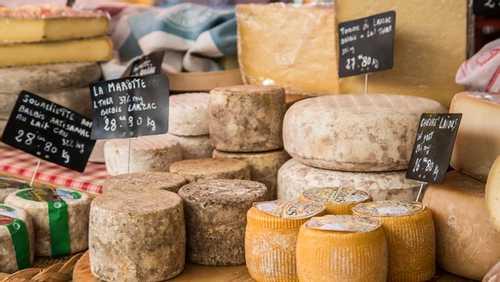Explore the World's Best Ideas
Join today and uncover 100+ curated journeys from 50+ topics. Unlock access to our mobile app with extensive features.
1,700 distinct varieties of cheese
Animal milk is used to create over 1,700 distinct varieties of cheese; creamy Brie, buttery Gouda, crumbly Parmesan, stringy mozzarella, sharp Cheddar, to name a few.
The staggering variety of cheeses is testimony to cheesemakers' creativity throughout the ages, but the real stars of the show are the microbes.
21
198 reads
From milk to cheese
All cheeses start from animal milk, including cow, buffalo, goat, sheep, and even camel.
- The milk is first warmed to a temperature ideal for microbes to flourish.
- Next, acid or rennet is added, alongside some 'starter' bacteria that causes the milk proteins and fats to coagulate, curdling the milk.
- The curds can be drained and chopped into chunks and scooped into moulds.
- The initial 'starter' bacteria die off over several weeks and other microbes take over to enhance the flavour that creates the potent flavours and aromas.
- Salt is added to stop microbes responsible for spoiling the process.
- The 'ripening' microbes break the proteins in the cheese into amino acids, many of which have their own flavour.
- Particularly voracious bacteria and fungi will break down amino acids even further to produce the truly smelly by-products.
21
123 reads
The source of cheese’s flavour
Over the months of ripening, smelly parts can interact in new ways to produce more flavour-carrying molecules, such as a hint of nutty, spicy, woody, grassy, or burnt oats. More fat in the cheese generally makes it tastier.
Flavour compounds typically dissolve well in oils, fats, and alcohol, but poorly in water. Fat-rich foods will therefore cover your tongue with a flavour that lingers.
21
106 reads
Smelly cheeses
Some microorganisms digest more than proteins, they also digest fat, such as the Penicillium moulds found in blue cheese. The broken-down molecules may have a peppery taste, while others create an off-putting stink.
One of the substances, known as mushroom alcohol, has a mouldy smell, also found in breath and sweat. The really stinky cheeses, such as Munster and Limburger, contain molecules identical to those given off from old socks.
20
89 reads
Craving cheese
Our food-obsessed minds crave novelty. When we have a new flavour offered, the desire to try something novel is irresistible.
There are also some scientific-sounding claims that cheese is as addictive as cocaine because it contains opium-like chemicals called casomorphin peptides.
28
242 reads
IDEAS CURATED BY
Elaina Y.'s ideas are part of this journey:
Learn more about health with this collection
How to find purpose and meaning in life
How to cultivate gratitude
Techniques for managing negative thoughts
Related collections
Similar ideas
11 ideas
The Best Healthy Foods to Gain Weight Fast
healthline.com
5 ideas
Small & Large Intestines: Intestinal Structure, Function, Diseases
probioticsline.com
5 ideas
Read & Learn
20x Faster
without
deepstash
with
deepstash
with
deepstash
Personalized microlearning
—
100+ Learning Journeys
—
Access to 200,000+ ideas
—
Access to the mobile app
—
Unlimited idea saving
—
—
Unlimited history
—
—
Unlimited listening to ideas
—
—
Downloading & offline access
—
—
Supercharge your mind with one idea per day
Enter your email and spend 1 minute every day to learn something new.
I agree to receive email updates

